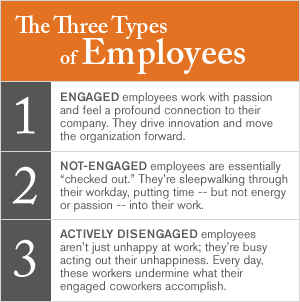The less satisfied you are with the physical setting of your work environment -- such as the acoustics, ventilation, or visual surroundings -- the more likely you are to be dissatisfied with your job, as most people would attest. And there are plenty of examples in popular culture that reinforce this idea. From comic strips such as "Dilbert" to movies like Office Space, cramped or unpleasant work environments are often presented in a humorous and satirical light.

|
The Gallup Management Journal recently surveyed U.S. employees to discover the truth behind the humor. While Gallup's employee engagement research has always shown that managers have the greatest influence on worker engagement, Gallup researchers also wanted to examine aspects of the physical work environment to determine which of them presented the biggest barriers to employee engagement and performance. (See "How Managers Trump Companies" in the "See Also" area on this page.)
The researchers studied employee responses to see which factors differed most strongly among engaged employees (31% of respondents) and those who were not engaged (52%) or actively disengaged (17%). (See sidebar "The Three Types of Employees" and graphic "The Cost of Disengagement.") Gallup research indicates that engaged employees are more productive, profitable, safer, create stronger customer relationships, and stay longer with their company than less-engaged employees. (See "Feedback for Real" and "The Four Disciplines of Sustainable Growth" in the "See Also" area on this page.)
The view from here
In the comic strip "Dilbert," hardly a week goes by without a jab at the downside of working in today's modern office, with its open-space floor plans and much-maligned cubicles. But the GMJ survey data suggest that the problem might not be the type of workspace that employees are given -- it might be that employees aren't allowed to make that space their own. When Gallup asked employees if they are able to personalize their workspace to make it feel like their own, employees who answered affirmatively to this question were 55% more likely to be engaged.
But workers want more than just a personal space; they want to be able to see beyond that space to the outdoors. In one memorable scene in the movie Office Space, the main character, Peter Gibbons, reacts to his company's "cubicle farm" environment by toppling a partition to obtain a better view. When the GMJ asked survey respondents if they can see outdoors from their workspace, 28% said they cannot. These employees are 86% more likely to be actively disengaged than those who are able to view the outside world from their workspace.
Too noisy? Too hot or too cold?
Not surprisingly, the GMJ found that feeling comfortable at work contributes substantially to worker engagement. When asked the question "Is the temperature in your work environment comfortable to you?" nearly one-quarter of all respondents (23%) answered no. Those employees are only half as likely to be engaged as employees who work in environments with comfortable temperatures. There is good news for managers who are trying to lead under these conditions, however. Among those employees who stated that their opinion counts at work, the percentage of employees who answer no to the temperature question drops to 13%. So, managers who pay attention to their employees' concerns will have an advantage.
Noise levels also had a significant impact on worker engagement. When asked, one in three employees indicated that noise in their workplace frequently disturbs their work. These employees -- like those who feel the temperature in their workplace is uncomfortable -- are about half as likely to be engaged when compared to respondents whose work environment is free of disturbing noises. For managers of employees who must cope with noisy working environments, it might be helpful to listen to what employees have to say. Among workers who said their opinions count, the rate of those who said that noise disturbs their work dropped to one in five.
What about employees who have it good -- whose workplaces are free from disturbing noises and uncomfortable temperatures? These workers are three times more likely to be engaged than those whose work environments are both noisy and uncomfortable. Clearly, the presence of both of these factors poses a greater threat to employee engagement than does either factor on its own.
The findings of the GMJ U.S. employee engagement survey show a strong relationship between workplace engagement and environmental factors such as noise, temperature, and personalized workspaces. Employees working in a comfortable environment are much more likely to be engaged and to make a positive contribution to the organization's financial success. The characters in "Dilbert" and Office Space clearly have their fair share of kindred spirits.

|
Results of these surveys are based on nationally representative samples of about 1,000 employed adults aged 18 and older. Interviews were conducted by The Gallup Organization by telephone quarterly from October 2000-October 2005, then semi-annually thereafter. For results based on samples of this size, one can say with 95% confidence that the error attributable to sampling and other random effects could be plus or minus three percentage points. For findings based on subgroups, the sampling error would be greater.